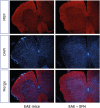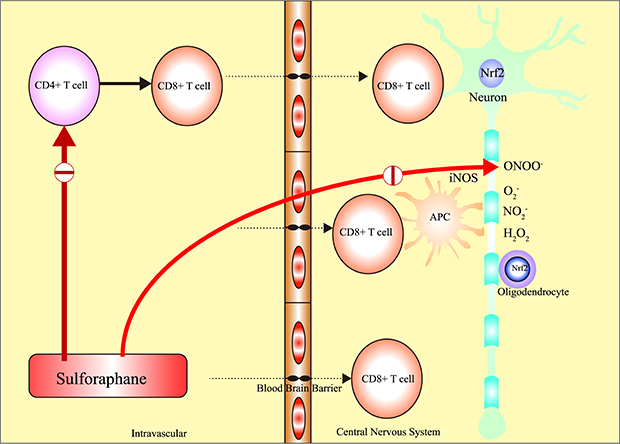1. Ellwardt E, Zipp F. Molecular mechanisms linking neuroinflammation and neurodegeneration in MS. Exp Neurol. 2014; 262:Pt A. 8–17.

2. GBD 2015 Neurological Disorders Collaborator Group. Global, regional, and national burden of neurological disorders during 1990–2015: a systematic analysis for the Global Burden of Disease Study 2015. Lancet Neurol. 2017; 16(11):877–897.
3. Lassmann H. Multiple sclerosis pathology. Cold Spring Harb Perspect Med. 2018; 8(3):a028936.

4. Reich DS, Lucchinetti CF, Calabresi PA. Multiple sclerosis. N Engl J Med. 2018; 378(2):169–180.

5. Weinshenker BG, Bass B, Rice GP, Noseworthy J, Carriere W, Baskerville J, et al. The natural history of multiple sclerosis: a geographically based study. I. Clinical course and disability. Brain. 1989; 112(Pt 1):133–146.
6. Bar-Or A. Immunology of multiple sclerosis. Neurol Clin. 2005; 23(1):149–175. vii

7. Frohman EM, Racke MK, Raine CS. Multiple sclerosis--the plaque and its pathogenesis. N Engl J Med. 2006; 354(9):942–955.
8. Compston A, Coles A. Multiple sclerosis. Lancet. 2008; 372(9648):1502–1517.

9. Walther EU, Hohlfeld R. Multiple sclerosis: side effects of interferon beta therapy and their management. Neurology. 1999; 53(8):1622–1627.

10. Wingerchuk DM, Carter JL. Multiple sclerosis: current and emerging disease-modifying therapies and treatment strategies. Mayo Clin Proc. 2014; 89(2):225–240.

11. Kim MJ, Sung JJ, Kim SH, Kim JM, Jeon GS, Mun SK, et al. The anti-inflammatory effects of oral-formulated tacrolimus in mice with experimental autoimmune encephalomyelitis. J Korean Med Sci. 2017; 32(9):1502–1507.

12. Gilgun-Sherki Y, Melamed E, Offen D. The role of oxidative stress in the pathogenesis of multiple sclerosis: the need for effective antioxidant therapy. J Neurol. 2004; 251(3):261–268.
13. Adamczyk B, Adamczyk-Sowa M. New insights into the role of oxidative stress mechanisms in the pathophysiology and treatment of multiple sclerosis. Oxid Med Cell Longev. 2016; 2016:1973834.

14. Ohl K, Tenbrock K, Kipp M. Oxidative stress in multiple sclerosis: central and peripheral mode of action. Exp Neurol. 2016; 277:58–67.

15. Yong H, Chartier G, Quandt J. Modulating inflammation and neuroprotection in multiple sclerosis. J Neurosci Res. 2018; 96(6):927–950.

16. Kansanen E, Kuosmanen SM, Leinonen H, Levonen AL. The Keap1-Nrf2 pathway: mechanisms of activation and dysregulation in cancer. Redox Biol. 2013; 1(1):45–49.

17. Talalay P, De Long MJ, Prochaska HJ. Identification of a common chemical signal regulating the induction of enzymes that protect against chemical carcinogenesis. Proc Natl Acad Sci U S A. 1988; 85(21):8261–8265.

18. Eastwood MA. Interaction of dietary antioxidants in vivo: how fruit and vegetables prevent disease? QJM. 1999; 92(9):527–530.

19. Itoh K, Wakabayashi N, Katoh Y, Ishii T, Igarashi K, Engel JD, et al. Keap1 represses nuclear activation of antioxidant responsive elements by Nrf2 through binding to the amino-terminal Neh2 domain. Genes Dev. 1999; 13(1):76–86.

20. Kraft AD, Johnson DA, Johnson JA. Nuclear factor E2-related factor 2-dependent antioxidant response element activation by tert-butylhydroquinone and sulforaphane occurring preferentially in astrocytes conditions neurons against oxidative insult. J Neurosci. 2004; 24(5):1101–1112.

21. Tarozzi A, Angeloni C, Malaguti M, Morroni F, Hrelia S, Hrelia P. Sulforaphane as a potential protective phytochemical against neurodegenerative diseases. Oxid Med Cell Longev. 2013; 2013:415078.

22. Bai Y, Wang X, Zhao S, Ma C, Cui J, Zheng Y. Sulforaphane protects against cardiovascular disease via Nrf2 activation. Oxid Med Cell Longev. 2015; 2015:407580.

23. Sestili P, Fimognari C. Cytotoxic and antitumor activity of sulforaphane: the role of reactive oxygen species. BioMed Res Int. 2015; 2015:402386.

24. Holloway PM, Gillespie S, Becker F, Vital SA, Nguyen V, Alexander JS, et al. Sulforaphane induces neurovascular protection against a systemic inflammatory challenge via both Nrf2-dependent and independent pathways. Vascul Pharmacol. 2016; 85:29–38.

25. Su X, Jiang X, Meng L, Dong X, Shen Y, Xin Y. Anticancer activity of sulforaphane: the epigenetic mechanisms and the Nrf2 signaling pathway. Oxid Med Cell Longev. 2018; 2018:5438179.

26. Kabat EA, Wolf A, Bezer AE. The rapid production of acute disseminated encephalomyelitis in rhesus monkeys by injection of heterologous and homologous brain tissue with adjuvants. J Exp Med. 1947; 85(1):117–130.

27. Olitsky PK, Yager RH. Experimental disseminated encephalomyelitis in white mice. J Exp Med. 1949; 90(3):213–224.

28. Lipton MM, Freund J. Encephalomyelitis in the rat following intracutaneous injection of central nervous system tissue with adjuvant. Proc Soc Exp Biol Med. 1952; 81(1):260–261.

29. Zhang H, Jarjour AA, Boyd A, Williams A. Central nervous system remyelination in culture--a tool for multiple sclerosis research. Exp Neurol. 2011; 230(1):138–148.
30. Procaccini C, De Rosa V, Pucino V, Formisano L, Matarese G. Animal models of multiple sclerosis. Eur J Pharmacol. 2015; 759:182–191.

31. Lassmann H, Bradl M. Multiple sclerosis: experimental models and reality. Acta Neuropathol. 2017; 133(2):223–244.

32. Pachner AR. Experimental models of multiple sclerosis. Curr Opin Neurol. 2011; 24(3):291–299.

33. Freund J, McDermott K. Sensitization to horse serum by means of adjuvants. Exp Biol Med. 1942; 49(4):548–553.

34. Munoz JJ, Bernard CC, Mackay IR. Elicitation of experimental allergic encephalomyelitis (EAE) in mice with the aid of pertussigen. Cell Immunol. 1984; 83(1):92–100.

35. Miller SD, Karpus WJ, Davidson TS. Experimental autoimmune encephalomyelitis in the mouse. Curr Protoc Immunol. 2010; Chapter 15:Unit 15.1.

36. Batoulis H, Recks MS, Addicks K, Kuerten S. Experimental autoimmune encephalomyelitis--achievements and prospective advances. APMIS. 2011; 119(12):819–830.
37. van der Star BJ, Vogel DY, Kipp M, Puentes F, Baker D, Amor S. In vitro and in vivo models of multiple sclerosis. CNS Neurol Disord Drug Targets. 2012; 11(5):570–588.
38. McRae BL, Kennedy MK, Tan LJ, Dal Canto MC, Picha KS, Miller SD. Induction of active and adoptive relapsing experimental autoimmune encephalomyelitis (EAE) using an encephalitogenic epitope of proteolipid protein. J Neuroimmunol. 1992; 38(3):229–240.

39. Berard JL, Wolak K, Fournier S, David S. Characterization of relapsing-remitting and chronic forms of experimental autoimmune encephalomyelitis in C57BL/6 mice. Glia. 2010; 58(4):434–445.

40. Rangachari M, Zhu C, Sakuishi K, Xiao S, Karman J, Chen A, et al. Bat3 promotes T cell responses and autoimmunity by repressing Tim-3–mediated cell death and exhaustion. Nat Med. 2012; 18(9):1394–1400.

41. Kappos L, Polman CH, Freedman MS, Edan G, Hartung HP, Miller DH, et al. Treatment with interferon beta-1b delays conversion to clinically definite and McDonald MS in patients with clinically isolated syndromes. Neurology. 2006; 67(7):1242–1249.

42. Mikol DD, Barkhof F, Chang P, Coyle PK, Jeffery DR, Schwid SR, et al. Comparison of subcutaneous interferon beta-1a with glatiramer acetate in patients with relapsing multiple sclerosis (the REbif vs glatiramer acetate in relapsing MS disease [REGARD] study): a multicentre, randomised, parallel, open-label trial. Lancet Neurol. 2008; 7(10):903–914.

43. Brinkmann V, Billich A, Baumruker T, Heining P, Schmouder R, Francis G, et al. Fingolimod (FTY720): discovery and development of an oral drug to treat multiple sclerosis. Nat Rev Drug Discov. 2010; 9(11):883–897.

44. Frohman EM, Brannon K, Alexander S, Sims D, Phillips JT, O'Leary S, et al. Disease modifying agent related skin reactions in multiple sclerosis: prevention, assessment, and management. Mult Scler. 2004; 10(3):302–307.
45. Herndon RM, Rudick RA, Munschauer FE 3rd, Mass MK, Salazar AM, Coats ME, et al. Eight-year immunogenicity and safety of interferon beta-1a-Avonex treatment in patients with multiple sclerosis. Mult Scler. 2005; 11(4):409–419.
46. Petersen B, Bendtzen K, Koch-Henriksen N, Ravnborg M, Ross C, Sorensen PS, et al. Persistence of neutralizing antibodies after discontinuation of IFNbeta therapy in patients with relapsing-remitting multiple sclerosis. Mult Scler. 2006; 12(3):247–252.
47. Stüve O. Knowns and unknowns in the future of multiple sclerosis treatment. J Neurol Sci. 2009; 287:Suppl 1. S30–S36.

48. Kieseier BC, Wiendl H, Hartung HP, Leussink VI, Stüve O. Risks and benefits of multiple sclerosis therapies: need for continual assessment? Curr Opin Neurol. 2011; 24(3):238–243.

49. Piehl F, Holmén C, Hillert J, Olsson T. Swedish natalizumab (Tysabri) multiple sclerosis surveillance study. Neurol Sci. 2011; 31:Suppl 3. 289–293.

50. Neuhaus O, Farina C, Wekerle H, Hohlfeld R. Mechanisms of action of glatiramer acetate in multiple sclerosis. Neurology. 2001; 56(6):702–708.

51. von Geldern G, Mowry EM. The influence of nutritional factors on the prognosis of multiple sclerosis. Nat Rev Neurol. 2012; 8(12):678–689.

52. Rasool M, Malik A, Qureshi MS, Manan A, Pushparaj PN, Asif M, et al. Recent updates in the treatment of neurodegenerative disorders using natural compounds. Evid Based Complement Alternat Med. 2014; 2014:979730.

53. Jensen GE, Clausen J. Glutathione peroxidase and reductase, glucose-6-phosphate dehydrogenase and catalase activities in multiple sclerosis. J Neurol Sci. 1984; 63(1):45–53.











 PDF
PDF Citation
Citation Print
Print




 XML Download
XML Download